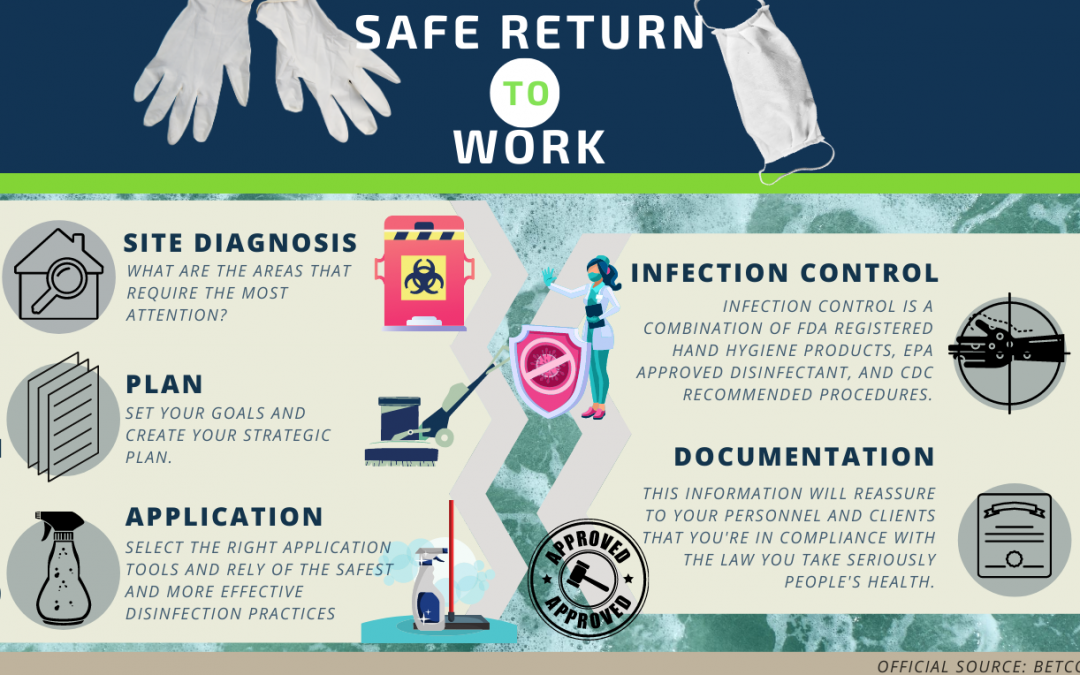While the efforts to bring the economy back to life and the preparation to adapt to a new normal post-pandemic world continue, businesses are carefully planning around the most cost-effective and safe ways to bring their employees back to work.
From reduced work hours to hiring a larger cleaning staff, to implementing work safety rules, the businesses are taking all measurements to stay afloat.
The cleanliness is a top priority and a law requirement that can involve fees, fines and even jail time, there’s a whole new level of strategic planning that has to be brought to the table for these times, and luckily for you, we are here to help you with that.
If you are a business owner yourself, you will want to read this, we will tell you how to use the most innovative smart tools available now to plan your cleaning strategy and disinfect you workspaces to get your employees to come back to work risk-free. With this information, you will be prepared to go from point A to B without stress added.
SITE DIAGNOSIS: WHAT ARE THE MOST CONCERNING AREAS IN YOUR COMPANY?
The first step is to find out from an insider’s perspective what are the areas that require the most attention and notate suggestions on what can be improved in terms of safety and disinfection practices. It’s recommended that you use protective gear or (PPE ) Personal Protective Equipment.
Identify the threads: Biological, chemical, or physical hazards.
- Biological: Animal material, molds, toxic or poisonous plants.
- Chemical: harmful chemicals, pesticides, heavy metals, and/or caustic substances.
- Physical: Structural issues, cold/hold surfaces, electricity, excessive noise, sharp surfaces.
THE PLAN: SET YOUR GOALS AND CREATE YOUR STRATEGIC PLAN.
Based on the preliminary information obtained from your on-site assessment, set your goals, and create your plan to sanitize your spaces.
There can be quite a few moving parts when creating a plan like this, you need to consider the direction and the quality of the indoor airflow, the presence of running water and electricity, having trained staff, and also waste removal options.
- Safe entry and exit: Pick a proper entrance and exit that are clean, away from any possible hazard. Include a transition zone to make it easy for people to stage chemicals and equipment, and put on or drop off the PPE.
- Hot areas: select the areas where the disinfection will take place.
- Critical touch points: Target the high-touch surfaces with the biggest potential of infection and create specific guidelines for those. These include light switches, door handles, trash cans, sinks, sink fixtures, chairs computers, tables, telephones, computers, etc.
- Cleaning products: A big part of the results you will get will depend on the products you use, so select those that are the most suitable for every activity that will take place.
- Equipment: Determine the equipment you will need to optimize your results i.e: microfiber cloths, wet floor signs, vacuum cleaner, etc.
APPLICATION: BEST TOOLS AND PRACTICES FOR CONSISTENT APPLICATION
In order to get your facilities to meet the standards, is crucial that you select the right application tools and rely on the safest and more effective disinfection practices. The EPA-approved disinfectant products are the best for this type of project.
Application practices:
- For disinfectant to go in full effect the surface has to be wet the entire time.
- Your device should be used at a coarse spray setting.
INFECTION CONTROL: THE PROCEDURES FOR EXTENSIVE INFECTION CONTROL.
Infection control is an important piece to take into account when wanting to get your spaces properly sanitized. It is a combination of FDA registered hand hygiene products, EPA approved disinfectant, and CDC recommended procedures.
Take precautions: Always handle yourself carefully and take all due precautions.
- When working on a cleaning project avoid eating, smoking, drinking, or using lip balm.
- Do not breathe chemicals.
- Do not compress the trash bags.
- In case of a spill do not splash.
- Discard sponges and towels used for cleaning.
- When handling a sharp object use tongs.
- Use labeled containers for disposal of equipment like gloves.
- Wash your hands after finalizing.
- Once are finished, disinfect containers and cleaning tools.
Procedures highlights:
- Use your PPE.
- Have your equipment and chemical prepared (properly diluted).
- Map out disinfecting paths to follow for each surface.
- Remove visible contaminations and pre-clean surfaces before applying a disinfectant.
- Thoroughly follow the cleaning steps depending on the surface: Hard surfaces (Non-porous), Soft surfaces (Porous), and Floors.
OFFICIAL RECORDS: DOCUMENTATION OF THE EXTENSIVE WORK AND TASKS PERFORMED.
Create documentation that backs up all the sanitation and disinfection tasks once completed the program. This information will reassure your personnel and clients that you’re in compliance with the law you take seriously people’s health.
You can use wall signs, certifications, or any other appropriate printed material for this purpose.
You can also find different resources online to inspect the workspaces prior to opening for the public, find more info here.
Take advantage of all this valuable information and plan your next steps to get your employees to return to a safe workplace.
If you have questions regarding this information, or if you need further guidance and professional help, do not hesitate on contacting us. We have been serving Oregon for over 20 years, with efficiency, integrity, and high-quality results and we would love to help you achieve your goals.
Contact us for a free quote today!

